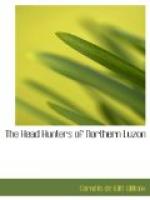I took advantage of the remaining hour or so of daylight to get a general view of things. One’s first impression of the Bontok Igorot is that he is violent and turbulent; it is perhaps more correct to say that, as compared with the Ifugao, he lacks discipline. It is certain that he is taller, without being stronger or more active or better built; in fact, as one goes north, the tribes increase in height and in wildness. The women share in the qualities noted. Both men and women were all over the place, and much vigorous dancing was going on. Using the same gansa as the Ifugao, the Igorot beats it on the convex side with a regular padded drumstick, whereas the Ifugao uses any casual stick on the concave side. Moreover, the Bontok dancers went around their circle, beating their gansas the while, in a sort of lope, the step being vigorous, long, easy, and high; as in all the other dances seen, the motion was against the sun. The gansa beat seemed to be at uniform intervals, all full notes. While our friends the Ifugaos were, on the whole, a quiet lot, these Bontok people seemed to be fond of making a noise, of shouting, of loud laughter. They appeared to be continually moving about, back and forth, restlessly and rapidly as though excited. On the whole, the impression produced by these people was not particularly agreeable; you felt that, while you might like the Banawe, you would always be on your guard against the Bontok. But it must be recollected that we had no such opportunity to see these people as we enjoyed in the case of Banawe and Andangle. The occasion was more exciting; they were more on show. It is not maintained that these are characteristics, simply that they appeared to be this afternoon and, indeed, during the remainder of our stay.




